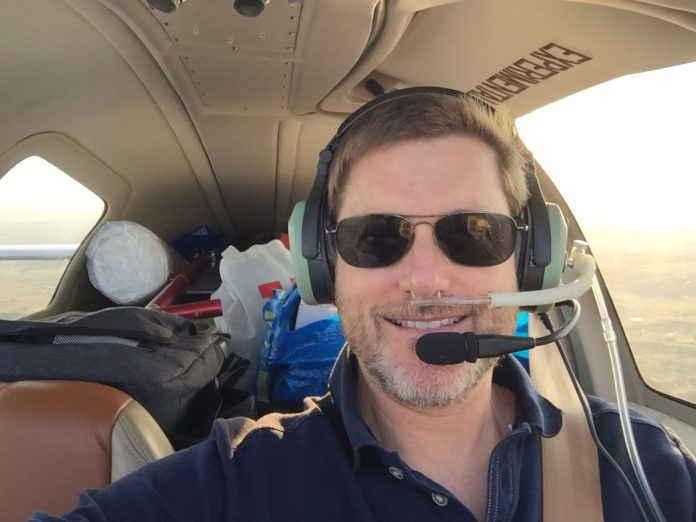
Working on water law and natural resources issues requires acute attention to detail. But it also helps to have the 17,000-foot view, which Kent Holsinger gets in more ways than one.
Holsinger, who manages a small law firm with locations in Denver and Telluride, is a lawyer-pilot who finds every way he can to incorporate his love of flying into his work. On many occasions he’s flown himself and other attorneys at his firm in his four-seat, single-engine airplane to court appearances, such as in federal court in Casper, Wyoming, or in Durango to argue a case. He’s also met clients in Colorado’s rural reaches and even taken them up in the air to survey and discuss issues regarding the land and water below.
Flying has been “such an amazing tool” in his practice, Holsinger said, not to mention a real quality-of-life benefit for getting around.
“We had clients in Cortez and Pagosa where the drive [to meet them] would be seven hours and the flight would be one, one and a half,” Holsinger said. “So when the weather was good, it was just tremendous to get down there with that kind of ease.”
His firm handles a variety of natural resources and wildlife issues. Lately its work has involved water law matters of all kinds, from rulemaking and legislation to water court litigation to even large property purchase negotiations, where the firm performs due diligence on ranch buys. Holsinger Law, which opened its doors in 2006, has also been working on endangered species issues, such as wind farm development that’s running up against the Bald and Golden Eagle Protection Act. Clients have run the gamut from individual ranchers to local governments and energy companies.
Holsinger grew up on a ranch in North Park, about a two-hour drive west of Fort Collins, where he was immersed not just in the state’s natural beauty but also its federal land and water issues. But law wasn’t his first choice of vocation.
“I’ve wanted to fly since I was a little kid,” Holsinger said. His eyesight didn’t meet the high standard to become a professional pilot, though, so he had to give up that dream. But 10 years ago, his legal work had him making mandatory trips to Montrose or Grand Junction three times in the span of four weeks, which can be four- to five-hour drives each way. He started taking a charter plane service out of Centennial Airport in the southwest Denver area, which cut the trip to Grand Junction to 45 minutes. People began suggesting that he ought to get a pilot’s license and fly himself. That was the nudge he needed to begin flight school.
Each morning during the week, Holsinger would arrive at Centennial Airport at 6 a.m. for ground school and eventually get a little flight time in, then go to the firm office and work all day and then return to the airport to study at night. After 90 days of that, he got his pilot’s license in 2009.
Holsinger bought a two-seater plane and was then flying it “to all corners of Colorado,” going to visit current and prospective clients or give presentations around the West. He’s also flown to New Mexico, Nevada, South Dakota, Texas, Utah and Wyoming for work, alone.
Holsinger has since upgraded to a Lancair Super ES, a single-engine piston airplane that seats four people including the pilot. It doesn’t have a pressurized cabin, so it can’t fly at 30,000 feet like an airliner, and he tends to take it over the mountains between 11,500 and 17,500 feet.
‘There’s No Substitute’
In the 10 years since Holsinger started flying planes for his work, technology has made physical distance a much smaller obstacle between lawyers and their clients. Zoom, Skype and other teleconferencing platforms have become part and parcel to law firms working with people even in far-flung corners of the state. Holsinger said that while it’s “wonderful” that attorneys have that technology now, that doesn’t make the plane obsolete for his purposes.
“There’s no substitute for being there in person,” he said. “And oftentimes, there’s no substitute for going out and looking at the landscape, and whatever particular project that might be, in person.” He recalled a time he took a rancher client up in the plane so she, for the first time ever, could see her property from the air.
“She got to point out all the different features on her ranch. And just to see her beam at that opportunity was just really special.”
Before he earned his wings, and before he’d even gone into private practice, Holsinger was assistant director for water at the Colorado Department of Natural Resources. He remembers riding in planes with the DNR director and the state commissioner of agriculture, “and those folks knew the state of Colorado like nobody’s business,” he said.
His superiors would point to a random-seeming reservoir or rural town below, name it and begin reminiscing about a state issue that once involved it. It was an ideal way to learn about Colorado’s procedural history and its geography at the same time.
Experiencing an area of land from the air lends the lawyer a unique perspective on a matter. Holsinger recalls flying over the Black Canyon of the Gunnison National Park after his firm had done a lot of permitting work on the Aspinall Unit reservoirs there. “Working on those issues and then flying over it has been really neat, too.”
Getting Off the Ground
Attorneys who spend countless hours at commercial airports or in their cars en route to court appearances might see the appeal of what Holsinger has done.
For those prospective pilots, buying an entry-level, two-seater plane isn’t quite as costly as they might think, Holsinger said. An attorney might purchase a used aircraft instead of a luxury car at around $50,000, depending on what they are looking for. But aircraft ownership becomes an even more serious investment when the pilot wants to upgrade from there. Online listings for a Lancair Super ES like Holsinger’s run from around $150,000 for one built in 2001 to nearly $500,000 for a newly-minted 2018 model.
As one would imagine, keeping a plane involves a lot more than just buying an aircraft and maintaining an active pilot’s license. Holsinger owns a hangar at Centennial Airport through a ground lease and pays a monthly fee to park his plane on the grounds. Also, air fuel isn’t cheap even for piston-engine planes like his, which run on gasoline that costs around $5 a gallon. His plane flies about 17 miles a gallon while cruising, and burns about 12 gallons an hour.
“It’s not an inexpensive proposition” to fly, Holsinger said. “But when you figure the time savings, the economics work pretty well for what we do here — that the time that I can be spending working for clients versus a seven-hour one-way drive is pretty remarkable.”

/ Doug Chartier, Law Week
Risks and Rewards
Flying a single-engine plane around the mountains of Colorado and all of the state’s not-so-predictable weather patterns can be risky as well. “The weather is a huge factor with a small airplane, and you have to be incredibly careful about when you go and when you don’t go,” he said. As the aviation adage goes, it’s always better to be on the ground wishing you were in the air than the other way around. Holsinger has at times experienced the latter. “I’ve had some teeth-rattling, scary experiences”
In 2011, a client was riding with him to a meeting in Cortez when the plane’s oil pressure gauge inexplicably dropped. They could see no smoke nor feel the plane shudder. They circled down to land in a small, abandoned landing strip. Seeing no problems upon further inspection, it turned out that it was just a sensor malfunction. “But that’s about as scary as it gets — your engine might go on you,” Holsinger said.
Another time, in 2009, he was flying the two-seater to Santa Fe, New Mexico, when the canopy started to separate from the airplane body, and he could feel a breeze inside the canopy. He found a deserted landing strip but decided to press on to the destination, where he ultimately landed and got the plane repaired and “buttoned up.”
“You could stick your hand outside at 14,000 feet and 200 miles an hour … and it was a pretty scary experience, but everything worked out fine,” he said.
But flying of course has its aesthetic rewards. Holsinger remembers a flight where he had to divert north from his normal route to Montrose to dodge a snowstorm that hit Monarch Pass in Gunnison, then he had to swing back south to Montrose. He got to see the Maroon Bells after the snow settled under sunny, clear skies. “To see those majestic peaks snow-covered in the glory of the day like that from the air was just beyond compare.”
Of all the routes Holsinger flies, his favorite is the one he takes to visit his parents’ ranch outside of Walden. He goes over Rollins Pass, over Lake Granby passing by Grand Lake on the left, over Stillwater Pass and into North Park.
His least favorite route, it turns out, is one that vexes both pilots and motorists.
“I’m not overly keen on the I-70 corridor,” he said. In the air, that route is “unforgiving” and there aren’t many outlets to take if the plane encounters weather or mechanical problems. Sometimes what’s true on land is also true in the air.
— Doug Chartier

